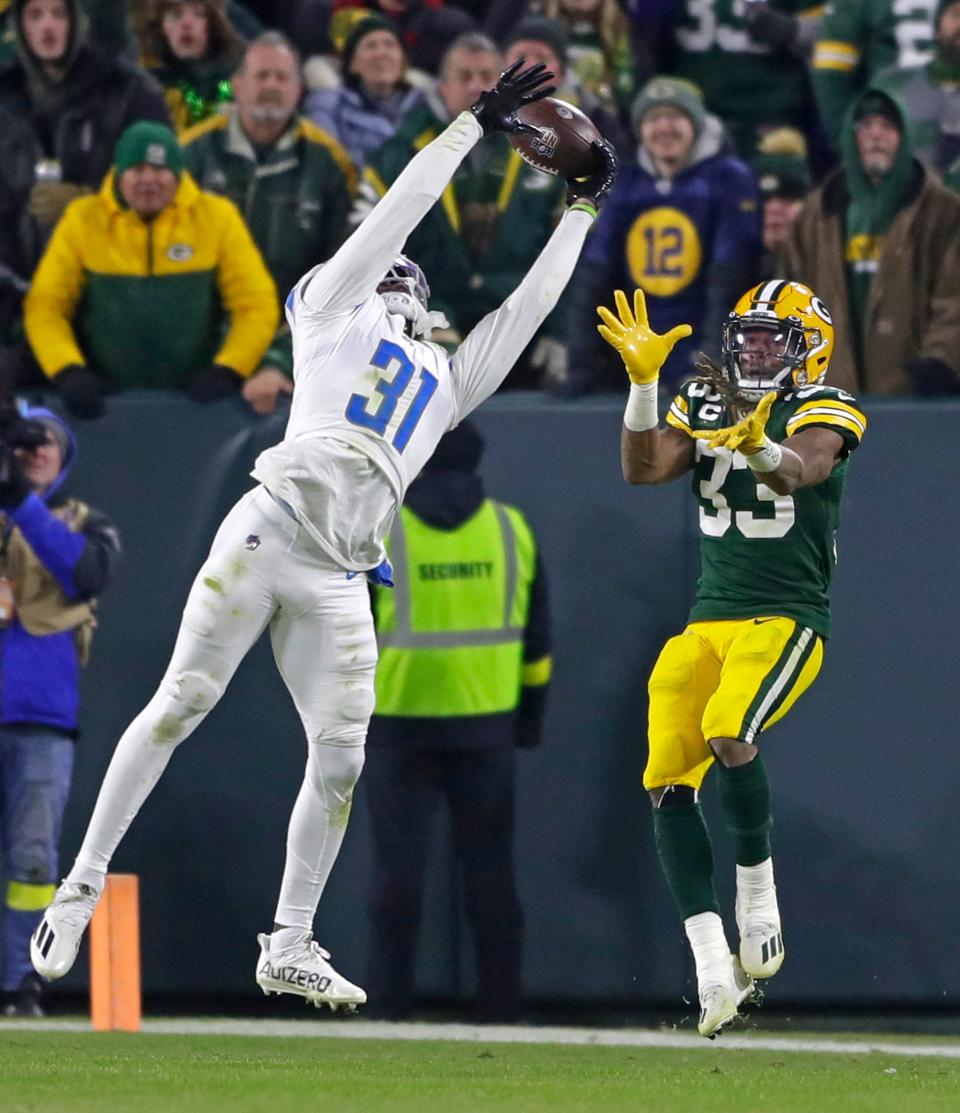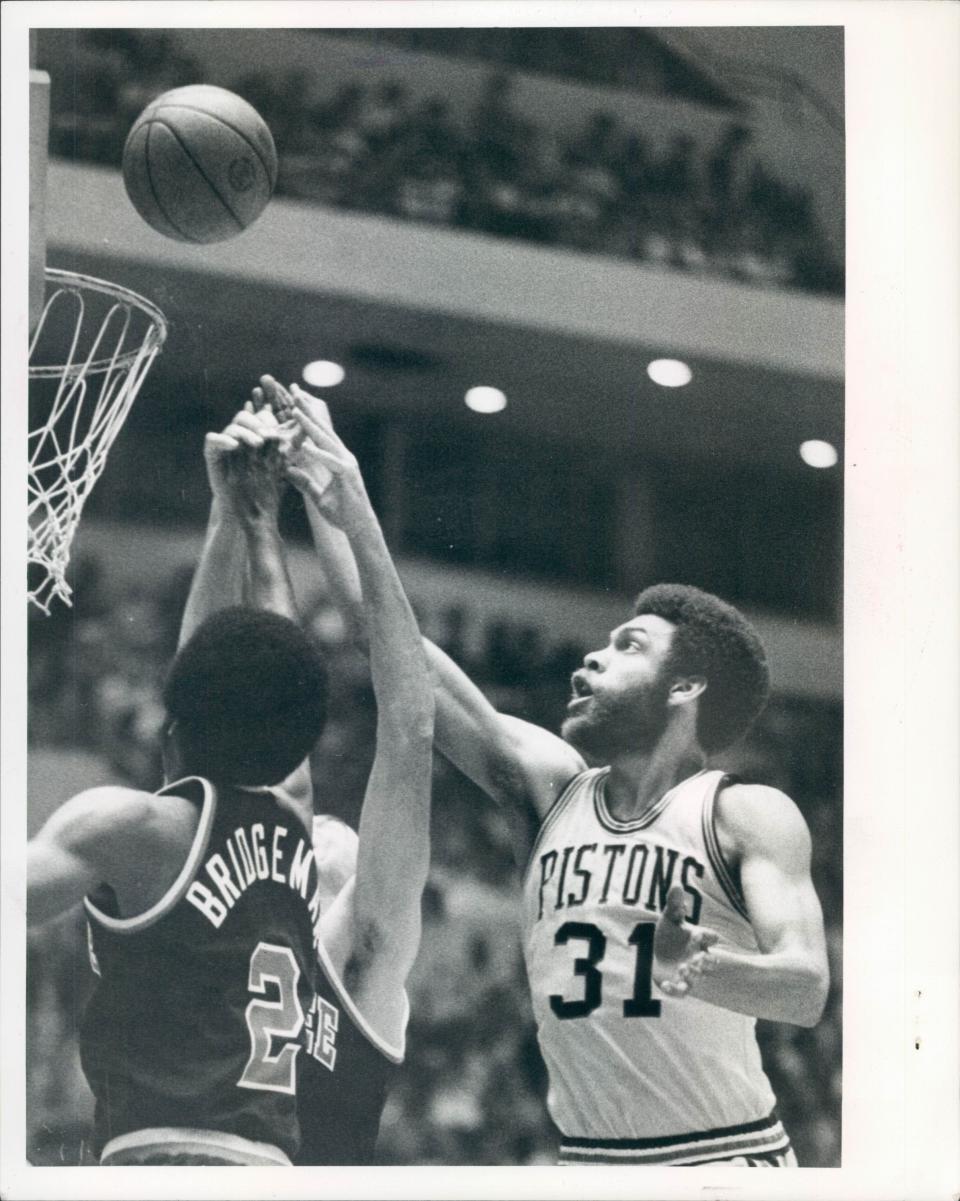Happy 3-1-3 Day! The best No. 3s, 13s and 31s in Detroit sports history
Happy March 13, or, as it’s known around Detroit (especially if you’ve watched a Pistons game lately), “3-1-3 Day!”
The day corresponding to the 313 area code that used to be Detroit’s one and only is a day to celebrate all things Detroit — especially since area codes 248, 586, 679, 734 and 947 don’t exactly lend themselves to a calendarial festival — and so we thought we’d check out which of Detroit’s big four pro teams has the best 3-1-3 combo.
For our purposes, that means a pair of players wearing either Nos. 3 and 13 or 31 and 3. (Don't worry, Lions fans, Joey Harrington didn't make the cut.) Is this a little arbitrary? Sure. But hey, we've got a while till we get Lions, Tigers or Pistons games that matter, so grab a coney, a bag of Better Made chips and a Faygo or a Vernors and get ready to drive down a 3-1-3 sporting memory lane …
Lions: No. 31 Kerby Joseph & No. 3 Eddie Murray

We’re running through the teams alphabetically, but, well, the positions generally mandated by NFL rule for Nos. 3, 13 and 31 — quarterback, wide receiver and defensive back, respectively — haven’t produced a lot of stars in Detroit over the past few … decades.
At No. 31, we’re going with a current Lion, despite just two seasons in Honolulu Blue, over former cornerback Corey Raymond. Raymond’s three seasons (1995-97) as a Lion featured a season with six interceptions, 68 tackles, two sacks and a forced fumble for a defense that ranked 23rd out of 30 teams in passing yards allowed ... and then just two more picks over the next two years. Joseph, meanwhile, has eight interceptions in just 32 games in 2022-23 and, of course, the safety will be remembered in franchise lore for catching the final pass by Aaron Rodgers as a Packer, ending Green Bay’s rally attempt in the 2022 season finale.
Before Harrington salted the memory of No. 3 in Lions fans’ hearts, there was kicker Eddie Murray — the first NFL player born in Nova Scotia — trotting out with it every Sunday as he put up points, what else, three at a time. Over his 12 seasons (1980-91) with the Lions, Murray connected on 325 of 344 field goal tries, a 75.1% success rate that wouldn’t get a tryout these days, but in his day earned Murray a spot on the Pro Football Hall of Fame’s All-1980s team. That run included two Pro Bowl berths, an All-Pro nod as a rookie and two seasons (1988-89) in which he led the NFL by making 95.2% of his field goal attempts. And, of course, Murray was almost automating on extra points, making 381 of 386 to finish with 1,113 points — at the time, tops in franchise history and still No. 2 (behind fellow kicker Jason Hanson).
Pistons: No. 31 George Trapp & No. 3 Ben Wallace

Trapp’s numbers in four seasons (1973-77) as a Piston — 8.6 points and 3.4 rebounds in 17 minutes a game — don’t leap off the screen. But those who saw the Detroit native play remembered it for years after, as his scoring touch — “He could flat-out shoot the basketball," longtime Pistons trainer Mike Abdenour told the Freep in 2002. "There was not a jump shot that he would not take.” — earned him the nickname “Instant Heat.”
Longtime Pistons announcer George Blaha described Trapp in 2002 as a trailblazer for future Pistons such as Vinnie “Microwave” Johnson: "We didn't call George 'Instant Heat' for nothing. He had no fear when it came to coming off the bench to score."
The Pistons since Trapp to wear the number have been less than impressive and, frankly, it’s surprising the Pistons didn’t burn No. 31 after the 2½ seasons spent by 2003 draft bust Darko Miličić wearing it. (Good luck to Evan Fournier, the second Piston this season to wear No. 31.)
Wallace, of course, is the Pistons’ most recent inductee into the Basketball Hall of Fame. Seemingly a throw-in on the sign-and-trade deal with Orlando that ended Grant Hill’s time in the 313, “Big Ben” became the embodiment of the “Goin’ to Work” title-winning Pistons. Over his first five seasons (2001-06) with the Pistons, Wallace averaged 12.9 rebounds and 2.8 blocks a game, more than making up for his occasionally spotty offense while earning four All-Star nods, four Defensive Player of the Year awards, five All-NBA honors and five All-Defense Team nods. And, again, we’re only counting his first stint in Detroit; he returned for three more seasons (2009-12) wearing No. 6.
Red Wings: No. 3 Marcel Pronovost & No. 13 Pavel Datsyuk
Pronovost, as so many Wings of the 1940s and ’50s did (who can forget Gordie Howe in a No. 17 sweater?), began his career in the higher numbers, wearing Nos. 21, 23 and 18 over his first two seasons. But once the lefty defenseman landed in No. 3 for the 1952-53 season, he clicked, with 72 goals, 200 assists and 643 penalty minutes — almost a gentlemanly total considering his 877 games played in the No. 3 sweater. Oh, and he also won four Stanley Cups, made four All-Star teams and finished in the top five in voting for the Norris Trophy (as the league’s best defenseman) five times. All before finishing his career with five seasons in Toronto (where he won a fifth Cup) and then being inducted into the Hockey Hall of Fame in 1978.
Meanwhile, just two players have worn No. 13 and the Winged Wheel — Slava Kozlov, from 1992-2001, and Pavel Datsyuk, from 2002-16 — for an incredible run of skill by one sweater number. Kozlov had 202 goals, 213 assists and a plus-134 rating in 607 games as a Wing and has a place in franchise history as a member of the Stanley Cup-winning “Russian Five” … but we’ve got to go with Datsyuk, who’ll make it into the Hall someday. The short list of Datsyuk’s accomplishments: 314 goals and 604 assists with a plus-249 rating in 953 games, two Cups, three Selke trophies (as the top defensive forward), three other Selke-finalist seasons, four Lady Byng trophies (for gentlemanly play) and a spot for “The Magic Man” on the NHL’s Top 100 Players for the league’s centennial in 2017-18.
Tigers: No. 3 Alan Trammell & No. 13 Lance Parrish

We were tempted to go with Alex Avila, the one Tiger to wear both Nos. 31 and 13. The catcher wore No. 13 in his first stint in Detroit putting up a .742 OPS, an All-Star nod and a Silver Slugger award over seven seasons (2009-15), then switched to No. 31 for his return in 2017, when he posted a slash line of .274/.394/.475 over 77 games.
Instead, we’ll go with a pair of teammates from the Tigers’ 1980s glory days, starting, of course, with the modern Mr. Tiger, Trammell. The SoCal native wore No. 42 for his first 19 games as a Tiger, in 1977, then opened 1978 as No. 3. That year, he finished fourth in AL Rookie of the Year voting, the true dawn of a 20-season career wearing the Old English D. Wearing No. 3, he hit .286 with 412 doubles, 185 home runs and 1,003 RBIs while making six AL All-Star squads and finishing in the top 10 in AL MVP voting three times. That includes the 1987 season, in which he posted a .343/.402/.551 slash line with 28 homers only to be robbed of the MVP by Toronto’s George Bell. At least Trammell won World Series MVP in 1984. (Trammell also wore No. 3 during his three seasons managing the Tigers from 2003-05, but, uh, we probably don’t want to remember those.)
And for our No. 13, we’ll go with Parrish; the “Big Wheel” also had a big postseason in 1984, homering in Game 1 of the '84 ALCS and then waiting nearly two weeks for his second postseason homer, a solo shot off Goose Gossage in the seventh inning of Game 5 of the World Series, an inning before Kirk Gibson’s iconic blast. In all, Parrish spent 10 seasons in Detroit, blasting 212 homers and driving in 700 runs over 1,146 games.
The verdict?
The four teams’ 3-1-3 combos each have their strengths and weaknesses — sorry, Lions — but we’ve got to go with the Wings’ pair (and that’s without including either of two 31s in net, Ed Giacomin or Curtis Joseph). Plus, we should get a bonus 3-1-3 Day whenever he’s finally picked for the Hockey Hall of Fame. He’s finally eligible as part of this fall’s class, after last logging 51 games — with 12 goals and 23 assists — as a 42-year-old in the KHL during the 2020-21 season. But tension over Russia’s invasion of Ukraine is likely to push the induction of any Russians into the Hall back a few years despite Datsyuk’s obvious qualifications. Maybe he'll be in by the 3-1-3 Day of '31?
Contact Ryan Ford at rford@freepress.com. Follow him on X (which used to be Twitter, y’know?) @theford. Read more on the Detroit Tigers and sign up for our Tigers newsletter.
This article originally appeared on Detroit Free Press: Happy 3-1-3 Day! The best No. 3s, 13s and 31s in Detroit sports history
